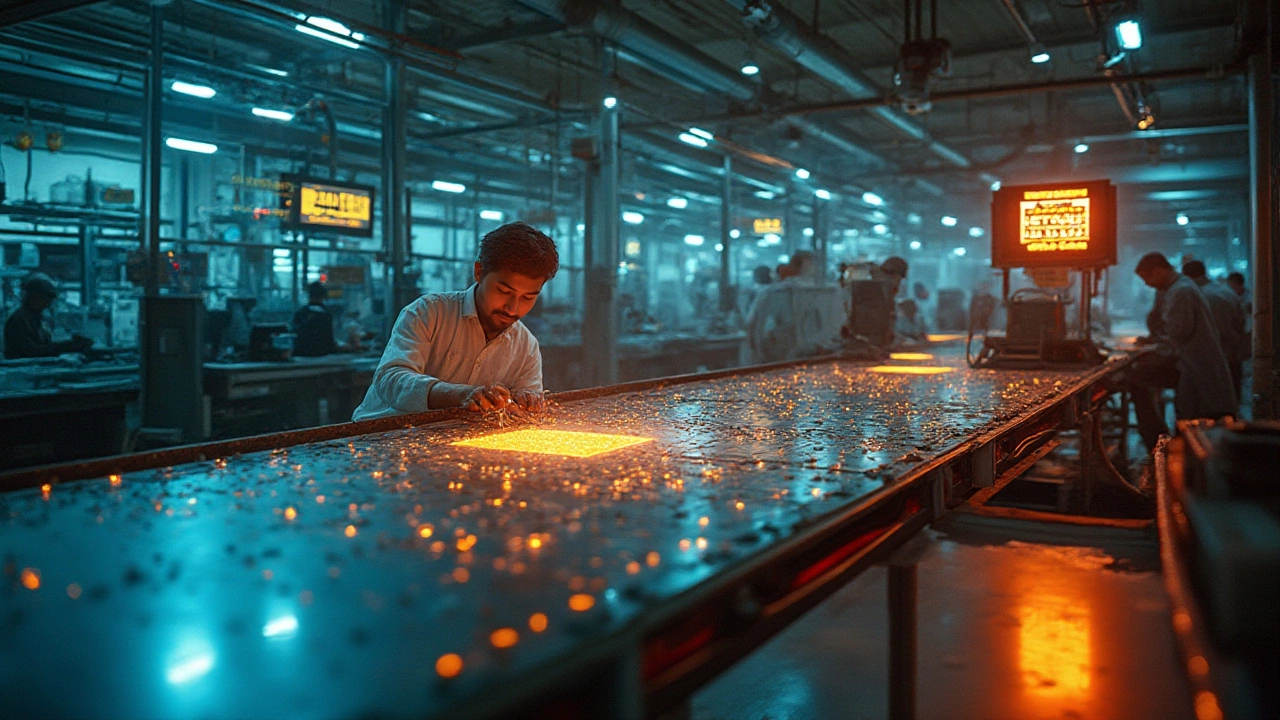If your phone buzzes right now, it’s thanks to a planet-wide relay of microchips, satellites, and software—a testament to breathtaking progress in electronics. But who’s steering this ship? It’s not always the country you expect, and the leaderboard can hinge on a single breakthrough chip, a trade regulation, or a pinch of rare earth minerals. When you drill into the world of advanced electronics, you’re not just peeking at a leaderboard of countries; you’re eavesdropping on a fierce rivalry where every nanometer counts.
The Global Powerhouses of Electronics
Ask someone who leads in electronics, and most folks will toss out three names: the United States, Japan, and South Korea. That’s a good start, but it’s hardly the full story. Let’s zoom out. Electronics isn’t just about the gadget in your pocket; it covers the chips inside airplanes, smart cities, and electric vehicles, too. Now, which country stands out?
The United States invented the microprocessor, gave us Apple and Intel, and is home to the chips that light up the world. American companies like NVIDIA, Qualcomm, and AMD crank out technologies that do the heavy lifting in AI, gaming, and data centers. But, even the cleverest American designers usually send their blueprints offshore to get their chips built.
Flip over to East Asia. South Korea’s Samsung is the world’s largest manufacturer of memory chips, and they’re only getting bolder; Samsung pledged $230 billion for chip production in South Korea by 2042. That’s a number that demands respect—and it’s not just about memory; they’re pushing boundaries in OLED displays and batteries too.
Japan, once the global king of consumer electronics, still leads in precision manufacturing. Sony and Panasonic may not sell as many TVs as before, but Japanese companies dominate when it comes to camera sensors, industrial robots, and the machinery that makes chips. In fact, over half of the global market for semiconductor manufacturing equipment is Japanese, according to a 2024 industry report by SEMI.
Then there’s Taiwan. TSMC—a company you’ve probably never heard of unless you really geek out on electronics—makes over 50% of the world’s advanced chips. Their 3-nanometer tech powers the newest iPhones and top AI hardware. No kidding: if TSMC has a hiccup, half the tech world holds its breath.
Don’t count out China. The world’s electronics production factory churns out everything from smartphones to solar panels, and no other country can match the scale. In 2023, China produced over 29 billion integrated circuits, pushing hard into advanced manufacturing despite facing export restrictions on the latest chip designs. The Chinese government has poured more than $150 billion into its semiconductor sector over the last decade, hoping to move from mass production into true innovation.
So, which country is most advanced? It depends on where you look: America leads in design and intellectual property, South Korea in memory, Japan in equipment, Taiwan in chip fabrication, and China in manufacturing scale. But if you mean bleeding-edge tech—the chips running today’s smartest devices—the experts usually put Taiwan and South Korea on top, with the United States not far behind.
Secrets Behind Their Success
You might wonder, what’s the secret sauce? How do certain places keep pulling ahead while others struggle? It’s never just about money—though high stakes never hurt. It’s a mix of relentless research, a hunger for competition, government support, and sometimes, just being in the right place at the right time.
Take Silicon Valley. The US has a knack for fostering innovation, thanks to a cocktail of top universities, crazy venture capital, and a culture that rewards big risks. The first transistor (which started this all) was born in Bell Labs, New Jersey. Fast-forward: American labs and companies have churned out breakthroughs in processors, wireless tech, and more. The country’s research investment was nearly $700 billion in 2024, with nearly a quarter poured into advanced tech and electronics.
South Korea, meanwhile, made a conscious bet decades ago. Samsung and LG got huge government backing after the Korean War, with tax breaks and aggressive support for exports. Engineers in Seoul work crazy hours—Samsung’s R&D spend alone was $18 billion last year, and they’re not shy about raiding competitors for the best talent.
Taiwan built its edge on pure engineering discipline and a willingness to pour money into foundries. TSMC is renowned for running its manufacturing lines around the clock; their ‘copy exactly’ approach keeps every tool, every setting, perfectly in sync. That’s why chip giants like Apple, AMD, and even Tesla trust them for their trickiest chips. Local universities partner tightly with industry, and the government props up new talent pipelines, making sure the next generation is hungry and ready.
Japan’s strength is patience and perfection. Their companies are obsessed with miniaturization and fail-safe manufacturing. You ever wonder why your digital camera’s autofocus never misses? Likely, it’s made with Japanese sensors. And when it comes to the gear other countries use to make electronics, Japanese firms like Tokyo Electron, Canon, and Nikon set the standard—sort of like making the best chef’s knives in the kitchen, even if they don’t cook the meal.
China? Scale and ambition. The government guides the whole sector, funding mega-projects through state-backed giants like SMIC and Huawei. Even after the US blacklisted top Chinese tech firms and cut the country off from advanced chip tools, Chinese engineers found makeshift workarounds, proving resourcefulness matters just as much as resources.
What does all this mean? If you want to build the next big thing in electronics, learn who does what: America for the brains, Korea and Taiwan for bleeding-edge production, Japan for tools and materials, China for mass production at warp speed.

Numbers That Tell the Story
All these claims are fun, but let’s get nerdy and look at real numbers. This is where things get fascinating. Here’s a table that puts the big players side by side in 2024:
| Country | Semiconductor Revenue (USD Billion) | R&D Spend (USD Billion) | Market Share of Electronics Production (%) | Main Strength |
|---|---|---|---|---|
| United States | 275 | 170* | 13 | Design, Innovation |
| China | 160 | 55 | 30 | Scaling, Mass Manufacturing |
| Taiwan | 165 | 20 | 15 | Advanced Manufacturing (Chips) |
| South Korea | 120 | 26 | 12 | Memory Chips, OLED |
| Japan | 55 | 22 | 8 | Equipment, Sensors |
*U.S. R&D spend figure includes software and integrated tech, not just hardware.
Notice something surprising? The United States still rakes in the highest chip revenues and dwarfs others in pure R&D. But China beats everyone at raw production scale. Taiwan, with a population of only 23 million, holds a massive wedge of advanced chip manufacturing, and South Korea dominates global supply of DRAM and NAND flash for all those solid-state drives you use daily.
Tech is shifting fast. In 2018, Korea eclipsed Japan and Europe in memory chips. By 2023, China overtook the US in consumer electronics output. But Taiwan now makes most of the ultra-advanced chips smaller than 7 nanometers—something only a handful of places can pull off.
Game-Changing Innovations and Future Trends
If you think electronics peaked with your latest phone, you’re due for a surprise. There’s a quiet arms race happening over who controls the next wave—quantum computing, AI chips, and “system-in-package” manufacturing.
TSMC and Samsung have both managed to make chips at the “3-nanometer” scale. What does that mean? You can fit billions more transistors onto a chip the size of a fingernail, making devices that are faster, smaller, and sip power instead of gulping it. Only three countries—Taiwan, South Korea, and the US—have cracked this code at scale so far.
American companies are sprinting toward artificial intelligence. NVIDIA’s latest GPU lineup, powered by TSMC manufacturing, is behind nearly every major AI app and datacenter upgrade in 2024. Meanwhile, Apple’s M2 Ultra chips, also made in Taiwan, wowed the market by blending power and efficiency for pro-grade laptops.
Japan isn’t sitting still. It leads research into gallium nitride and silicon carbide—materials for chips that don’t overheat easily, crucial for electric vehicles and 5G towers. In medical devices and industrial robots, Japanese electronics set the benchmark worldwide.
China wants to leapfrog into self-sufficiency. Its “Made in China 2025” plan is rallying every government agency and private firm. By 2024, China’s homegrown SMIC made headlines for shipping 7-nanometer chips—despite lacking the ultra-advanced EUV machines only Dutch company ASML makes (and which the US and Europe won’t sell to China). That’s a sign of serious ingenuity and national willpower.
Looking forward: electronic packaging (building complete systems on a chip), photonics (using light for computing), and neuromorphic designs (chips that mimic brain behavior) are all on the radar. Keep an eye on eco-friendly electronics too; many countries are racing to shrink the energy appetite of chips and tackle recycling.

What This Means for Your Business or Career
If you’re hustling in this industry or just want to stay future-proof, it pays to know where the action is. Want to work on the world’s tiniest chip? Head to Taiwan or South Korea. Interested in robotics, sensors, and smart automation? Japan’s your place. Fancy being at the epicenter of bold new inventions and AI? The United States keeps leading the charge. Or maybe you’re after speed and scale, where products go from concept to millions sold in a blink—China is unmatched there (just beware the shifting export laws).
Tips for success? First, stay curious; whatever’s cutting-edge now will be standard-issue in three years. Get familiar with how global supply chains really work, because your innovative device can’t ship without the right chip, made in a foundry 5,000 miles away. If you’re picking up new skills, learn the basics of semiconductor design, embedded software, and system integration; these abilities open doors in every one of these powerhouse nations.
The market is short on top engineers and creative thinkers who play at the crossroads of hardware and software. Even if you’re not an engineer, opportunities abound in logistics, sales, marketing, and regulation; each country’s ecosystem is desperate for great communicators and problem-solvers.
To sum it all up? The race for the most advanced electronics isn’t settled and probably never will be. Each country brings its secret weapon: America’s creativity, Korea’s precision, Taiwan’s manufacturing magic, Japan’s relentless perfection, and China’s factory muscle. They keep each other sharper. And as long as they race against each other, our gadgets will keep getting faster, brighter, cooler—and maybe just a bit more mysterious.
